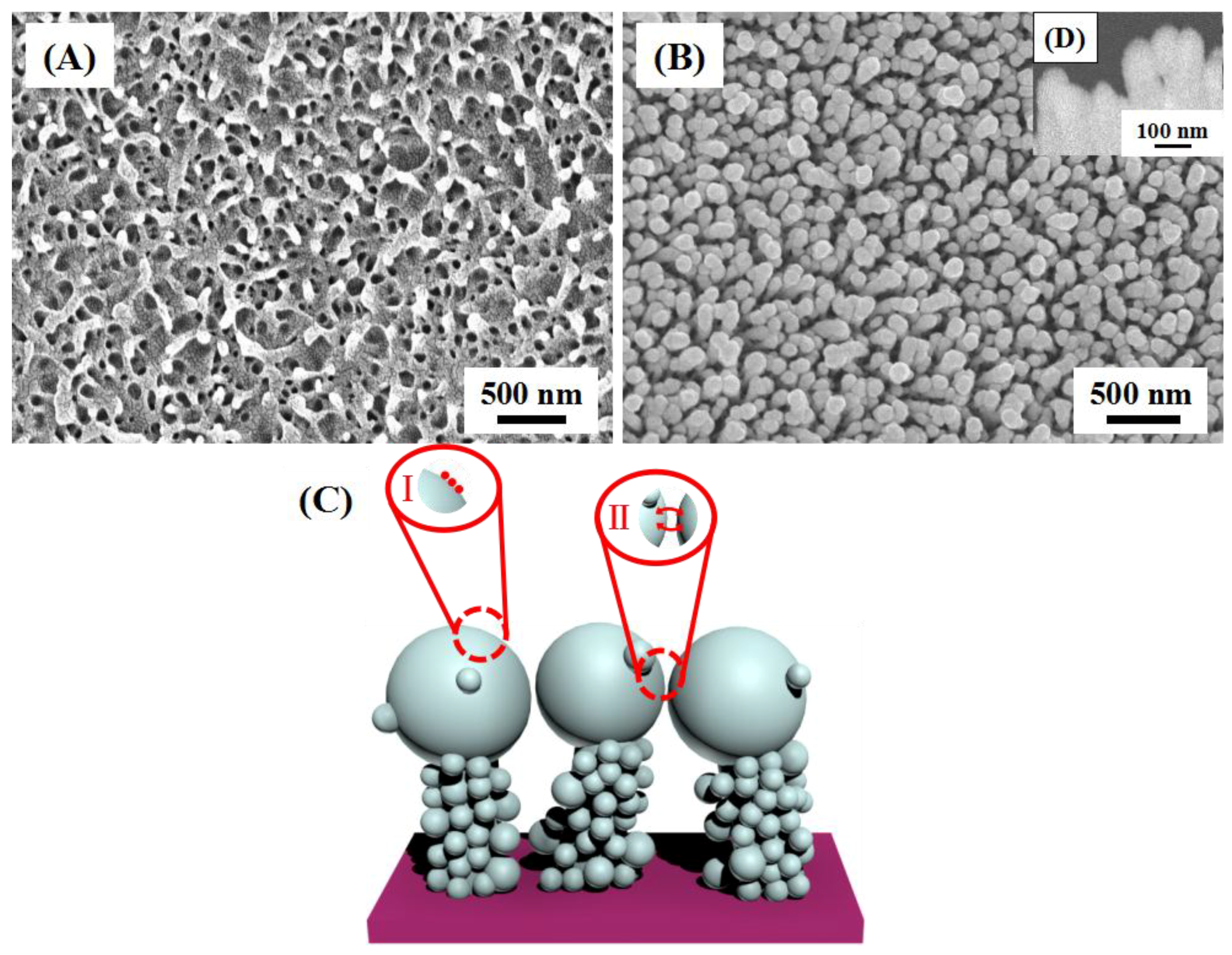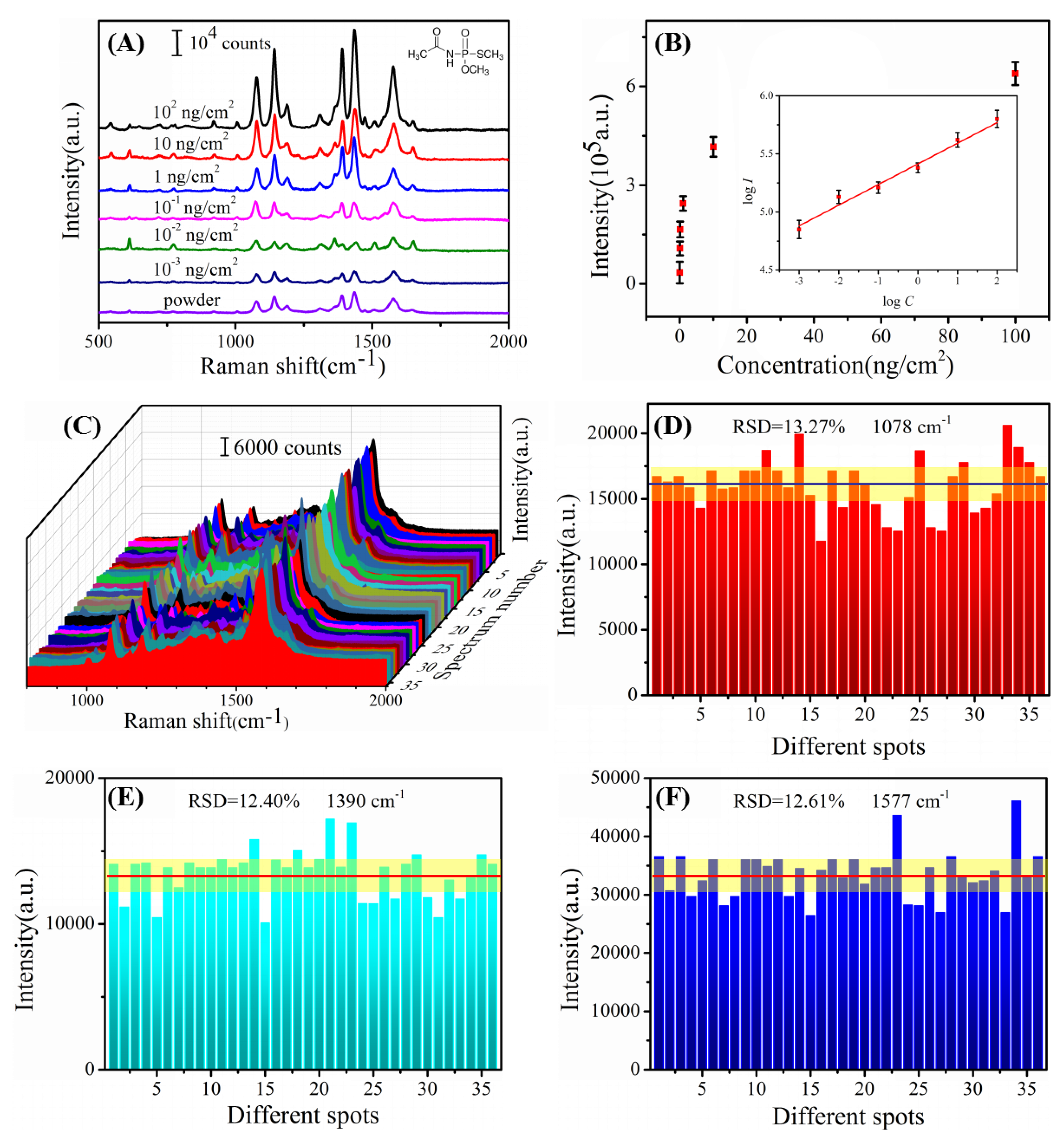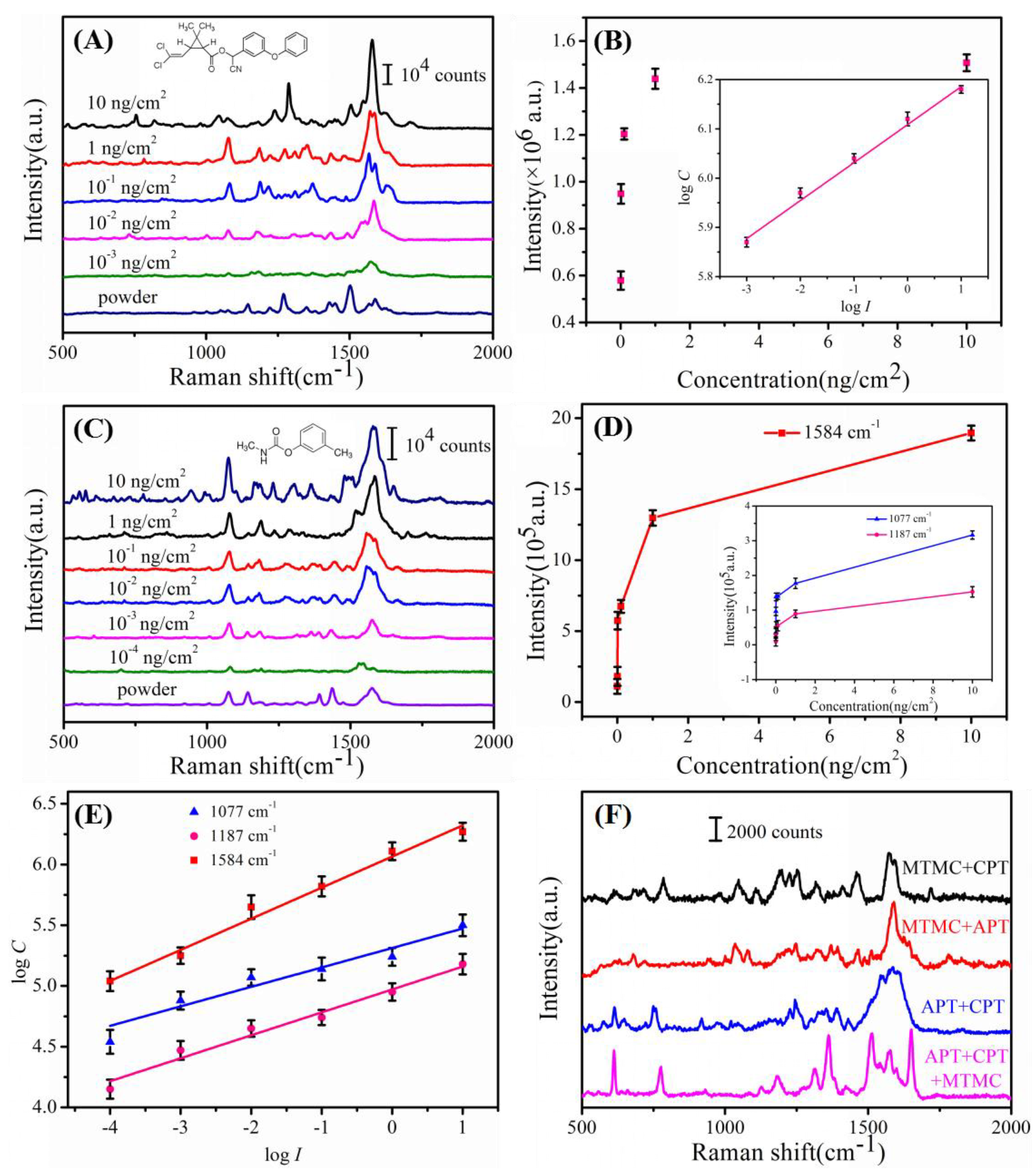Au-Decorated Dragonfly Wing Bioscaffold Arrays as Flexible Surface-Enhanced Raman Scattering (SERS) Substrate for Simultaneous Determination of Pesticide Residues
Abstract
:1. Introduction
2. Experimental
2.1. Materials and Instruments
2.2. Sample Preparation
2.3. Characterization
2.4. Detection of Pesticide Residues on Apple Peels
3. Results and Discussion
3.1. Morphology Characterization
3.2. SERS Performances of the Au/DW Substrate
3.3. Detection of Pesticide Residues Collected by Au/DW Substrate
3.4. Simultaneous Detection of Multifold Pesticide Residues on Apple Peels
4. Conclusions
Author Contributions
Funding
Conflicts of Interest
References
- Valeeva, N.; Meuwissen, M.P.M.; Huirne, R.B.M. Economics of food safety in chains: A review of general principles. NJAS Wagen. J. Life Sci. 2004, 51, 369–390. [Google Scholar] [CrossRef]
- Schieberle, P.; Molyneux, R.J. Quantitation of sensory-active and bioactive constituents of food: A journal of agricultural and food chemistry perspective. J. Agric. Food Chem. 2012, 60, 2404–2408. [Google Scholar] [CrossRef] [PubMed]
- Rohit, J.V.; Kailasa, S.K. Cyclen dithiocarbamate-functionalized silver nanoparticles as a probe for colorimetric sensing of thiram and paraquat pesticides via host-guest chemistry. J. Nanopart. Res. 2014, 16, 2585–2600. [Google Scholar] [CrossRef]
- Omar, N.; Bakar, J.; Muhammad, K. Determination of organochlorine pesticides in shrimp by gas chromatography-mass spectrometry using a modified QuEChERS approach. Food Control 2013, 34, 318–322. [Google Scholar] [CrossRef]
- Bhamore, J.R.; Jha, S.; Mungara, A.K.; Singhal, R.K.; Sonkeshariya, D.; Kailasa, S.K. Onestep green synthetic approach for the preparation of multicolor emitting copper nanoclusters and their applications in chemical species sensing and bioimaging. Biosens. Bioelectron. 2016, 80, 243–248. [Google Scholar] [CrossRef] [PubMed]
- Hou, J.Y.; Dong, J.; Zhu, H.S.; Teng, X.; Ai, S.Y.; Mang, M.L. A simple and sensitive fluorescent sensor for methyl parathion based on l-tyrosine methyl ester functionalized carbon dots. Biosens. Bioelectron. 2015, 68, 20–26. [Google Scholar] [CrossRef] [PubMed]
- Carvalho, F.P. Pesticides, environment, and food safety. Food Energy Secur. 2017, 6, 48–60. [Google Scholar] [CrossRef]
- Lee, K.M.; Herrman, T.J. Determination and prediction of fumonisin contamination in maize by surface-enhanced Raman spectroscopy (SERS). Food Bioprocess Technol. 2016, 9, 588–603. [Google Scholar] [CrossRef]
- Wang, Q.; Wu, D.; Chen, Z.D. Ag dendritic nanostructures for rapid detection of thiram based on surface-enhanced Raman scattering. RSC Adv. 2015, 5, 70553–70557. [Google Scholar] [CrossRef]
- Zhang, Y.Z.; Wang, Z.Y.; Wu, L.; Pei, Y.W.; Chen, P.; Cui, Y.P. Rapid simultaneous detection of multi-pesticide residues on apple using SERS technique. Analyst 2014, 139, 5148–5154. [Google Scholar] [CrossRef] [PubMed]
- Jamil, A.K.M.; Izake, E.L.; Sivanesan, A.; Fredericks, P.M. Rapid detection of TNT in aqueous media by selective label free surface enhanced Raman spectroscopy. Talanta 2015, 134, 732–738. [Google Scholar] [CrossRef] [PubMed]
- Ilkhani, H.; Hughes, T.; Zhong, C.J.; Hepel, M. Nanostructured SERS-electrochemical biosensors for testing of anticancer drug interactions with DNA. Biosens. Bioelectron. 2016, 80, 257–264. [Google Scholar] [CrossRef] [PubMed]
- Fu, C.; Wang, Y.; Chen, G.; Yang, L.Y.; Xu, S.P.; Xu, W. Aptamer-based surface-enhanced Raman scattering-microfluidic sensor for sensitive and selective polychlorinated biphenyls detection. Anal. Chem. 2015, 87, 9555–9558. [Google Scholar] [CrossRef] [PubMed]
- Zheng, H.; Ni, D.; Yu, Z.; Liang, P. Preparation of SERS-active substrates based on graphene oxide/silver nanocomposites for rapid detection of l-Theanine. Food Chem. 2017, 217, 511–516. [Google Scholar] [CrossRef] [PubMed]
- Moskovits, M. Surface-enhanced Raman spectroscopy: A brief retrospective. J. Raman Spectrosc. 2005, 36, 485–496. [Google Scholar] [CrossRef]
- Yang, L.B.; Liu, H.L.; Ma, Y.M.; Liu, J.H. Solvent-induced hot spot switch on silver nanorod enhanced Raman spectroscopy. Analyst 2012, 137, 1547–1549. [Google Scholar] [CrossRef] [PubMed]
- Chen, J.M.; Huang, Y.J.; Kannan, P.; Zhang, L.; Lin, Z.Y.; Zhang, J.W.; Chen, T.; Guo, L.H. Flexible and adhesive surface enhance Raman scattering active tape for rapid detection of pesticide residues in fruits and vegetables. Anal. Chem. 2016, 88, 2149–2155. [Google Scholar] [CrossRef] [PubMed]
- Zhou, N.N.; Meng, G.W.; Huang, Z.L.; Ke, Y.; Zhou, Q.T.; Hu, X.Y. A flexible transparent Ag-NC@PE film as a cut-and-paste SERS substrate for rapid in situ detection of organic pollutants. Analyst 2016, 141, 5864–5869. [Google Scholar] [CrossRef] [PubMed]
- Zhu, Y.Q.; Li, M.Q.; Yu, D.Y.; Yang, L.B. A novel paper rag as ‘D-SERS’ substrate for detection of pesticide residues at various peels. Talanta 2014, 128, 117–124. [Google Scholar] [CrossRef] [PubMed]
- Zhu, J.; Liu, M.J.; Li, J.J.; Li, X.; Zhao, J.W. Multi-branched gold nanostars with fractal structure for SERS detection of the pesticide thiram. Spectrochim. Acta A 2018, 189, 586–593. [Google Scholar] [CrossRef] [PubMed]
- Dougan, J.A.; Faulds, K. Surface enhanced Raman scattering for multiplexed detection. Analyst 2012, 137, 545–554. [Google Scholar] [CrossRef] [PubMed]
- Wang, P.; Wu, L.; Lu, Z.C.; Li, Q.; Yin, W.M.; Ding, F.; Han, H.Y. Gecko-inspired nanotentacle surface-enhanced Raman spectroscopy substrate for sampling and reliable detection of pesticide residues in fruits and vegetables. Anal. Chem. 2017, 89, 2424–2431. [Google Scholar] [CrossRef] [PubMed]
- Wang, X.B.; Song, C.; Geng, K.W.; Zeng, F.; Pan, F. Photoluminescence and Raman scattering of Cu-doped ZnO films prepared by magnetron sputtering. Appl. Surf. Sci. 2007, 253, 6905–6909. [Google Scholar] [CrossRef]
- Song, H.T.N.; Webb, H.K.; Hasan, J.; Tobin, M.J.; Crawford, R.J. Dual role of outer epicuticular lipids in determining the wettability of dragonfly wings. Colloids Surf. B 2013, 106, 126–134. [Google Scholar]
- Zhang, C.X.; Su, L.; Chan, Y.F. Ag@SiO2 core-shell nanoparticles on silicon nanowire arrays as ultrasensitive and ultrastable substrates for surface-enhanced Raman scattering. Nanotechnology 2013, 24, 335501–335509. [Google Scholar] [CrossRef] [PubMed]
- Sivashanmugan, K.; Liao, J.D.; Liu, B.H.; Yao, C.K.; Luo, S.C. Ag nanoclusters on ZnO nanodome array as hybrid SERS-active substrate for trace detection of malachite green. Sens. Actuators B Chem. 2015, 207, 430–436. [Google Scholar] [CrossRef]
- Yin, P.G.; Jiang, L.; You, T.T.; Zhou, W.; Li, L.; Guo, L.; Yang, S. Surface-enhanced Raman spectroscopy with self-assembled cobalt nanoparticle chains: Comparison of theory and experiment. Phys. Chem. Chem. Phys. 2010, 12, 10781–10785. [Google Scholar] [CrossRef] [PubMed]
- Wei, G.; Wang, L.; Liu, Z.G.; Song, Y.H.; Sun, L.L.; Yang, T.; Li, Z. DNA-network-templated self-assembly of silver nanoparticles and their application in surface-enhanced Raman scattering. J. Phys. Chem. B 2005, 109, 23941–23947. [Google Scholar] [CrossRef] [PubMed]
- Parsons, H.M.; Ekman, D.R.; Collette, T.W.; Viant, M.R. Spectral relative standard deviation: A practical benchmark in metabolomics. Analyst 2009, 134, 478–485. [Google Scholar] [CrossRef] [PubMed]
- Zhang, B.H.; Wang, H.S.; Lu, L.H.; Ai, K.L.; Zhang, G.; Cheng, X.L. Large-area silver-coated silicon nanowire arrays for molecular sensing using surface enhanced Raman spectroscopy. Adv. Funct. Mater. 2010, 18, 2348–2355. [Google Scholar] [CrossRef]
- Damalas, C.A.; Eleftherohorinos, I.G. Pesticide exposure, safety issues, and risk assessment indicators. Int. J. Environ. Res. Public Health 2011, 8, 1402–1419. [Google Scholar] [CrossRef] [PubMed]
- Liu, B.H.; Han, G.M.; Zhang, Z.P.; Liu, R.Y.; Jiang, C.L.; Wang, S.H.; Han, M.Y. Shell thickness-dependent Raman enhancement for rapid identification and detection of pesticide residues at fruit peels. Anal. Chem. 2012, 84, 255–261. [Google Scholar] [CrossRef] [PubMed]
- Clauson, S.L.; Sylvia, J.M.; Arcury, T.A.; Summers, P.; Spencer, K.M. Detection of pesticides and metabolites using surface-enhanced Raman spectroscopy (SERS): Acephate. Appl. Spectrosc. 2015, 7, 785–793. [Google Scholar] [CrossRef] [PubMed]







| Modes | Solid | SERS | Band Assignment |
|---|---|---|---|
| 11(b1) | 825 | πCH | |
| 18a(a1) | 1005 | 1007 | γCC + γCCC |
| 7a(a1) | 1087 | 1077 | νCS |
| 9b(b2) | 1140 | δCH | |
| 9a(a1) | 1177 | 1185 | δCH |
| 7a(a1) | 1290 | νCH | |
| 3b(b2) | 1390 | ||
| 19a(a1) | 1492 | νCC + δCH | |
| 19b(b2) | 1443 | νCC + δCH | |
| 8a(a1) | 1593 | 1586 | νCC |
| Raman peaks (cm−1) | 1077 | 1140 | 1185 | 1390 | 1443 | 1586 |
| RSD values | 9.29% | 9.95% | 9.85% | 10.60% | 10.36% | 12.15% |
| Fruit Peels | LOD | LOQ |
|---|---|---|
| Apple | 1 × 10−3 ng/cm2 | 0.625 ng/cm2 |
| Peak/cm−1 | Linear Function | R2 |
|---|---|---|
| 1077 | y = 0.16x + 5.31 | 0.911 |
| 1187 | y = 0.19x + 4.97 | 0.967 |
| 1584 | y = 0.26x + 6.07 | 0.985 |
© 2018 by the authors. Licensee MDPI, Basel, Switzerland. This article is an open access article distributed under the terms and conditions of the Creative Commons Attribution (CC BY) license (http://creativecommons.org/licenses/by/4.0/).
Share and Cite
Wang, M.; Shi, G.; Zhu, Y.; Wang, Y.; Ma, W. Au-Decorated Dragonfly Wing Bioscaffold Arrays as Flexible Surface-Enhanced Raman Scattering (SERS) Substrate for Simultaneous Determination of Pesticide Residues. Nanomaterials 2018, 8, 289. https://doi.org/10.3390/nano8050289
Wang M, Shi G, Zhu Y, Wang Y, Ma W. Au-Decorated Dragonfly Wing Bioscaffold Arrays as Flexible Surface-Enhanced Raman Scattering (SERS) Substrate for Simultaneous Determination of Pesticide Residues. Nanomaterials. 2018; 8(5):289. https://doi.org/10.3390/nano8050289
Chicago/Turabian StyleWang, Mingli, Guochao Shi, Yanying Zhu, Yuhong Wang, and Wanli Ma. 2018. "Au-Decorated Dragonfly Wing Bioscaffold Arrays as Flexible Surface-Enhanced Raman Scattering (SERS) Substrate for Simultaneous Determination of Pesticide Residues" Nanomaterials 8, no. 5: 289. https://doi.org/10.3390/nano8050289




